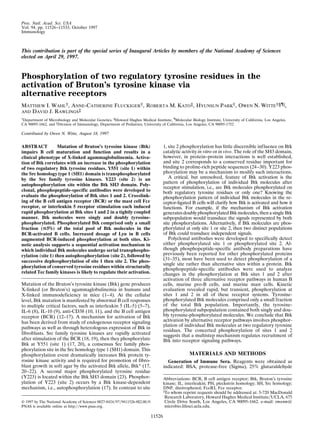More Related Content
Similar to Wahl et al. PNAS 1997 (dragged)
Similar to Wahl et al. PNAS 1997 (dragged) (20)
More from Hyunsun Park (9)
Wahl et al. PNAS 1997 (dragged)
- 1. Proc. Natl. Acad. Sci. USA
Vol. 94, pp. 11526–11533, October 1997
Immunology
This contribution is part of the special series of Inaugural Articles by members of the National Academy of Sciences
elected on April 29, 1997.
Phosphorylation of two regulatory tyrosine residues in the
activation of Bruton’s tyrosine kinase via
alternative receptors
MATTHEW I. WAHL†, ANNE-CATHERINE FLUCKIGER†, ROBERTA M. KATO‡, HYUNSUN PARK†, OWEN N. WITTE†§¶i,
AND DAVID J. RAWLINGS‡
†Department of Microbiology and Molecular Genetics, §Howard Hughes Medical Institute, ¶Molecular Biology Institute, University of California, Los Angeles,
CA 90095-1662, and ‡Division of Immunology, Department of Pediatrics, University of California, Los Angeles, CA 90095-1752
Contributed by Owen N. Witte, August 18, 1997
ABSTRACT Mutation of Bruton’s tyrosine kinase (Btk)
impairs B cell maturation and function and results in a
clinical phenotype of X-linked agammaglobulinemia. Activa-
tion of Btk correlates with an increase in the phosphorylation
of two regulatory Btk tyrosine residues. Y551 (site 1) within
the Src homology type 1 (SH1) domain is transphosphorylated
by the Src family tyrosine kinases. Y223 (site 2) is an
autophosphorylation site within the Btk SH3 domain. Poly-
clonal, phosphopeptide-specific antibodies were developed to
evaluate the phosphorylation of Btk sites 1 and 2. Crosslink-
ing of the B cell antigen receptor (BCR) or the mast cell Fc´
receptor, or interleukin 5 receptor stimulation each induced
rapid phosphorylation at Btk sites 1 and 2 in a tightly coupled
manner. Btk molecules were singly and doubly tyrosine-
phosphorylated. Phosphorylated Btk comprised only a small
fraction (<5%) of the total pool of Btk molecules in the
BCR-activated B cells. Increased dosage of Lyn in B cells
augmented BCR-induced phosphorylation at both sites. Ki-
netic analysis supports a sequential activation mechanism in
which individual Btk molecules undergo serial transphospho-
rylation (site 1) then autophosphorylation (site 2), followed by
successive dephosphorylation of site 1 then site 2. The phos-
phorylation of conserved tyrosine residues within structurally
related Tec family kinases is likely to regulate their activation.
Mutation of the Bruton’s tyrosine kinase (Btk) gene produces
X-linked (or Bruton’s) agammaglobulinemia in humans and
X-linked immunodeficiency in mice (1–4). At the cellular
level, Btk mutation is manifested by abnormal B cell responses
to multiple critical factors, such as interleukin 5 (IL-5) (5–7),
IL-6 (8), IL-10 (9), anti-CD38 (10, 11), and the B cell antigen
receptor (BCR) (12–17). A mechanism for activation of Btk
has been derived from study of endogenous receptor signaling
pathways as well as through heterologous expression of Btk in
fibroblasts. Src family tyrosine kinases are rapidly activated
after stimulation of the BCR (18, 19), then they phosphorylate
Btk at Y551 (site 1) (17, 20), a consensus Src family phos-
phorylation site in the Src homology type 1 (SH1) domain. This
phosphorylation event dramatically increases Btk protein ty-
rosine kinase activity and is required for promotion of fibro-
blast growth in soft agar by the activated Btk allele, Btk* (17,
20–22). A second major phosphorylated tyrosine residue
(Y223) is located within the Btk SH3 domain (23). Phosphor-
ylation of Y223 (site 2) occurs by a Btk kinase-dependent
mechanism, i.e., autophosphorylation (17). In contrast to site
1, site 2 phosphorylation has little discernible influence on Btk
catalytic activity in vitro or in vivo. The role of the SH3 domain,
however, in protein–protein interactions is well established,
and site 2 corresponds to a conserved residue important for
binding to proline-rich peptide sequences (24–30). Y223 phos-
phorylation may be a mechanism to modify such interactions.
A critical, but unresolved, feature of Btk activation is the
pattern of phosphorylation of individual Btk molecules after
receptor stimulation, i.e., are Btk molecules phosphorylated on
both regulatory tyrosine residues or only one? Knowing the
phosphorylation pattern of individual Btk molecules in the re-
ceptor-ligated B cells will clarify how Btk is activated and how it
functions. For example, if the mechanism of Btk activation
generates doubly phosphorylated Btk molecules, then a single Btk
subpopulation would transduce the signals represented by both
site phosphorylations. Alternatively, if Btk molecules are phos-
phorylated at only site 1 or site 2, then two distinct populations
of Btk could transduce independent signals.
Polyclonal antibodies were developed to specifically detect
either phosphorylated site 1 or phosphorylated site 2. Al-
though phosphopeptide-specific antibody preparations have
previously been reported for other phosphorylated proteins
(31–35), most have been used to detect phosphorylation of a
single site rather than alternative sites within a protein. Btk
phosphopeptide-specific antibodies were used to analyze
changes in the phosphorylation at Btk sites 1 and 2 after
activation of three alternative receptor pathways in human B
cells, murine pro-B cells, and murine mast cells. Kinetic
evaluation revealed rapid, but transient, phosphorylation at
sites 1 and 2 in all of these receptor systems. Tyrosine-
phosphorylated Btk molecules comprised only a small fraction
of the total Btk population. Importantly, the tyrosine-
phosphorylated subpopulation contained both singly and dou-
bly tyrosine-phosphorylated molecules. We conclude that Btk
activation by alternative receptor pathways involves phosphor-
ylation of individual Btk molecules at two regulatory tyrosine
residues. The concerted phosphorylation of sites 1 and 2
suggests that a multistep mechanism regulates recruitment of
Btk into receptor signaling pathways.
MATERIALS AND METHODS
Generation of Immune Sera. Reagents were obtained as
indicated: BSA, protease-free (Sigma), 25% glutaraldehyde
© 1997 by The National Academy of Sciences 0027-8424y97y9411526-8$2.00y0
PNAS is available online at http:yywww.pnas.org.
Abbreviations: BCR, B cell antigen receptor; Btk, Bruton’s tyrosine
kinase; IL, interleukin; PH, pleckstrin homology; SH, Src homology;
DNP, dinitrophenol; Fc´RI, Fc´ receptor.
i
To whom reprint requests should be addressed at: 5-720 MacDonald
Research Laboratory, Howard Hughes Medical InstituteyUCLA, 675
Circle Drive South, Los Angeles, CA 90095-1662. e-mail: owenw@
microbio.lifesci.ucla.edu.
11526
